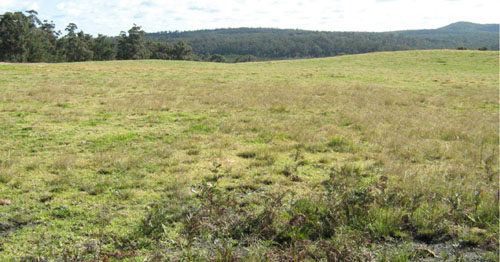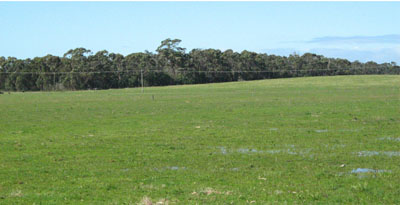Croajingalong (Symbol: Cj)
EG245
Geology
Recent aeolian sediments.
Landform
Dunefield comprising of low dunes, swales (shallow broad depressions) and plains. This map unit is associated with coastal areas behind the foredunes and south of the lowlands of the Waygara map unit. . The map unit may be subdivided into low dunes, plains and broad depressions.

Low dunes east of Marlo typical of component 2
Original vegetation
Banksia woodland with areas of wet heathland. This includes areas of Coastal Sclerophyll Forest, Coastal Heath and Banksia species.
Soils
The soils are typically deep acidic sands generally with a layer of variably cemented sands (or ‘coffee rock’) at depth.
Component 1: Soils on the plains.
On the plains the surface soils are very dark grey to black acidic sands with high amounts of organic matter. Below are paler acidic sands which in turn overlay dark coloured cemented sands or coffee rock. Coffee rock is an accumulation of organic-aluminium and/or organic-sesquioxide complexes (iron and aluminium oxides) cemented sands and generally occurs before 1 m.
Component 2: Soils on the dunes.
The dune soils are similar but the surface soils are generally not as black and the coffee rock tends to be softer.
Component 3: Soil on the depressions.
Although not examined, the soils in the depressions are also likely to be black acidic sands with high amounts of organic matter in the surface and coffee rock in the subsoil.
Land use
Some of the area has been cleared for grazing and urban development, but most of the public land is part of the Croajingalong National Park.
Site EG245
| Location: Marlo | Geo. Ref. 0638500E 5815600N |
| Australian Soil Classification: Melacic Humic/Humosequic, Semiaquic PODOSOL | Deep acidic black sand |
| General landscape description: Undulating rises | |
| Geology: Recent aeolian sediments | |
| Site description: Level | |
| Land use: Residential subdivision (undeveloped) | |
| Native vegetation: Banksia Woodland and Wet Heathland | |
| Mapping unit: Croajingalong (Component 1) |

Undulating plains and low dunes typical of the Marlo map unit. Photo taken on the Marlo
Plains Road about 8 km east of the sampled site.
Soil profile morphology
| Surface soil | ||
A1 | 0 – 50 cm | Black (10YR2/1); loamy sand; clear change to: |
A2 | 50 – 60 cm | Greyish brown (10YR5/2); loamy sand; abrupt change to: |
Subsoil | ||
Bhs | 60 -65 cm | Dark brown (10YR3/3); cemented sand; clear change to |
B2 | 65 – 80 cm | Yellowish brown mottled with light yellowish brown; clayey sand. |
Soil profile characteristics
| Horizon | Depth | EC | pH water | pH CaCl2 | Exchangeable cations meq/100 g | Ca:Mg | ESP | ||||||
| cm | dS/m | Ca | Mg | K | Na | Total | H | CEC | |||||
| A1 | 0-20 | <0.05 | 4.9 | 3.6 | 0.33 | 0.28 | 0.03 | 0.28 | 0.92 | 1.3 | 2.0 | 1.2 | 14 |
| B2 | 65-80 | 0.08 | 5.8 | 4.7 | 0.48 | 0.58 | 0.05 | 0.58 | 1.69 | 0.99 | 3.3 | 0.8 | 18 |
Samples analysed by: Industry and Investment NSW (2010)
Management considerations
- The surface soil is strongly acid and a response to lime would be expected.
- The surface soil has a very low inherent fertility (based on the sum of the exchangeable basic cations). Such strongly leached soils are also likely to be naturally deficient in nitrogen, phosphorus, sulphur and potassium.


